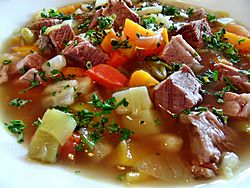Pichelsteiner facts for kids
 |
|
| Type | Stew |
|---|---|
| Place of origin | Germany |
| Main ingredients | Meat (beef, pork and mutton), vegetables (potatoes, carrots, parsley, cabbage, leeks), meat broth |
Pichelsteiner is a yummy and hearty stew from Germany. It's packed with different kinds of meat and lots of healthy vegetables, making it a super filling meal!
Contents
How to Make Pichelsteiner
Making this stew is quite simple. First, different types of meat are cooked until they are nicely browned. This usually includes beef, pork, and mutton.
Adding Vegetables and Cooking
After the meat is seared, lots of fresh vegetables are added to the pot. These often include potatoes, diced carrots, and parsley roots. You'll also find cut cabbage and leek in the mix. Sometimes, people even add diced onions and garlic for extra flavor!
Then, a tasty meat broth is poured over everything. The whole mixture is cooked together slowly until all the ingredients are tender. The stew usually becomes quite thick and delicious.
Serving Pichelsteiner
In a region of Germany called Swabia, people sometimes serve the marrow from the bones (used to make the broth) with the stew. Because Pichelsteiner is so easy to make, it's often cooked in big kitchens for many people, like in schools or cafeterias.
The Story Behind the Name
The name Pichelsteiner has an interesting history! One story says it was created by a woman named Auguste Winkler. She was an innkeeper in a town called Grattersdorf in Germany.
Mountain and Festival Connection
Many people believe the name comes from a nearby mountain called Büchelstein. Since 1839, a special festival has been held there every year. At this outdoor cooking festival, people enjoyed eating this stew. Because of how the local people pronounced the letter ü (like i), the dish became known as Pichelsteiner.
The Pot Story
Another idea about the name comes from the town of Regen. Since 1874, people there have met every year to eat Pichelsteiner together. They believe the name comes from the type of pot used to cook the stew. In the past, this kind of cooking pot was called a pichel.
First Mention in Cookbooks
No matter which story is true, Pichelsteiner became very popular. It was first written down in a cookbook in 1894, showing how long this yummy German stew has been enjoyed!

